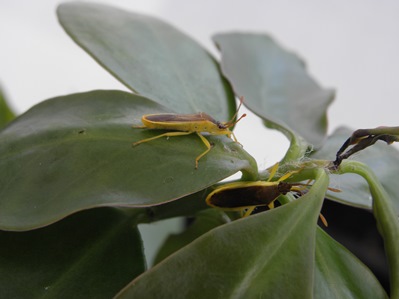
The biological control agent to the invasive plant pereskia will be released into South Africa for the first time in a public release ceremony on 10 October 2014 at Rhodes University in Grahamstown.
The Department of Agriculture, Forestry and Fisheries (DAFF) has recently granted permission to release the pereskia stem-wilter (Catorhintha schaffneri) in South Africa as a biological control agent to pereskia.
Pereskia grows in ecologically sensitive and difficult to access areas making control using herbicides and physical removal difficult. The plant can also reproduce from small fragments, so after clearing operations the tiny fragments of the plant that are left behind will grow into new plants. The weed grows intertwined with indigenous plants so pereskia cannot be removed without killing indigenous plants too.
Pereskia stem-wilter feeds on the shoot tips of pereskia and is very damaging to the alien plants making it a perfect biological control agent.
Pereskia (Pereskia aculeata) is an invasive alien plant that was brought to South Africa in 1858 as a botanical curiosity. It destroys South African native biodiversity by smothering indigenous plants and killing large forest trees which collapse under the weight of the weed. Infested forests become degraded ecosystems with very low levels of biodiversity.
Rhodes University lead researcher, Dr Iain Paterson from the Department of Zoology and Entomology said sufficient numbers of pereskia stem-wilter have been reared and are ready for release.
He said they have recently been moved out of quarantine and mass rearing efforts are underway at the Waainek greenhouses. The pereskia stem-wilters are fed plant cuttings from infestations growing around Grahamstown.
“It is one of the worst weeds in South Africa,” said Dr Paterson. The Working for Water Programme (WfW) of the Department of Environmental Affairs: Natural Resource Management programme (DEA:NRM) funded research into biological control of pereskia because of the damage it is causing to indigenous forests.
Dr Paterson has been working with the insect since 2007 and has been raising them in quarantine since 2012. The pereskia stem-wilter was imported into quarantine and was subjected to host specificity testing. This testing is designed to identify which plants the insect can feed on.
“After many years of research it is now clear that the pereskia stem-wilter can only survive on pereskia and will die if it is forced to feed on any other plant. If the insect is given a choice it will always choose to feed on pereskia. This means that if the pereskia stem-wilter is released in South Africa it will feed on pereskia only and will not harm any indigenous plants or crops,” he explained.
Quarantine is a lot warmer than in the tunnels but they have done climatic matching to ensure that the pereskia stem-wilter can survive in South African temperatures. The insect which is native to Brazil will prefer the warmer conditions of South Africa’s North-East coastline which is ideally suited as pereskia is causing the most damage in those regions.
“We hope to release about 300 at each site that we identify. And the sites are all the way from Port St Johns to about Kosi Bay,” explained Paterson.
Unlike herbicidal and physical removals, biological control is environmentally friendly and sustainable.
It is a long term solution and only damages the target weed, not the surrounding vegetation. Mass rearing efforts will also take place at the South African Sugar Research Institute (SASRI) and releases will be made at sites infested with pereskia throughout the country.
Release Details:
10 October 16:00-16:30
Stanley Kidd Residence Parking, Nelson Mandela Hall
